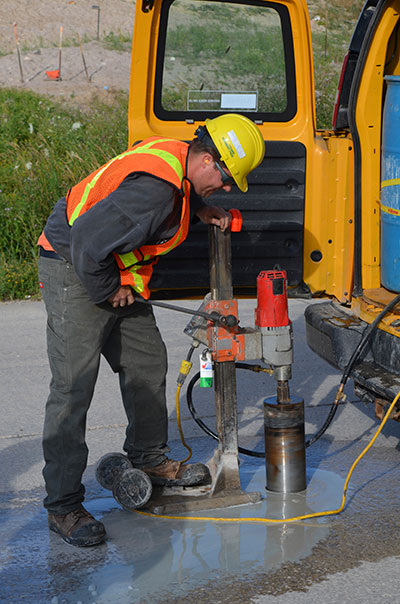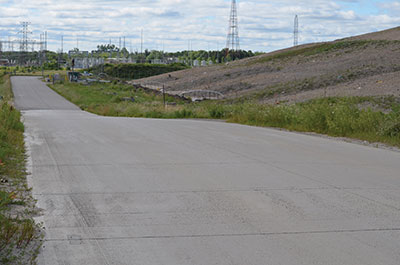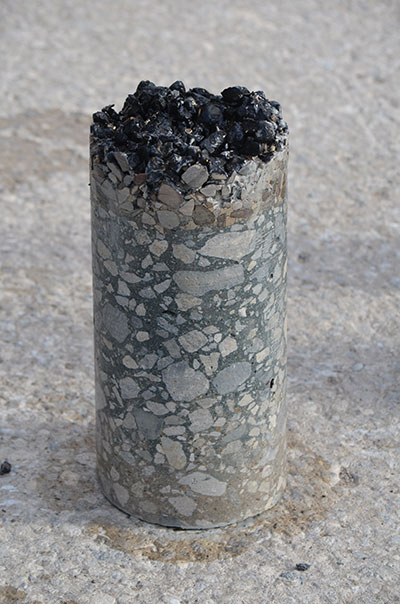
Features
Columns
Education
Testing Recycled Aggregates
CPATT uses a test track to research recycled aggregates on roads.
December 2, 2013 By Andrew Macklin
Inside the Region of Waterloo’s Waste Management facility, the Centre
for Pavement and Transportation Technology (CPATT) at the University of
Waterloo is doing important research on the viability of using recycled
aggregates in road construction.
Inside the Region of Waterloo’s Waste Management facility, the Centre for Pavement and Transportation Technology (CPATT) at the University of Waterloo is doing important research on the viability of using recycled aggregates in road construction. The research involves the construction of a test track that uses a multitude of different asphalt and concrete road surfaces. These surfaces in turn use different mixes of recycled materials and specialty pavements.

|
|
CPATT’s mandate is to study the preservation and replacement of Canada’s public infrastructure. The centre’s work includes such aspects of road construction as structural design, geotechnical engineering and intelligent transportation systems. The funding for CPATT has been provided by a number of industry partners, including McAsphalt Industries Limited, the Ministry of Transportation, OHMPA and a host of others. CPATT’s body of work from over 40 years of research and development has given it both national and international recognition.
In the summer of 2013, CPATT conducted a full forensic evaluation of the test track.
The test track contains a series of sections of road that test a variety of different types of road paving materials: concrete with varying degrees of recycled aggregate mix, stone mastic asphalt, polymer-modified asphalt, regular hot mix, Superpave, as well as asphalt with recycled asphalt shingles.

|
|
| The test track is part of the road network at the Region of Waterloo Waste Management facility in Waterloo, Ont.
|
Included in the evaluation of the test track in 2013 was an extensive test, both internally and externally, of the concrete sections. The concrete road portion of the track includes four sections using different material composition: 100 per cent virgin concrete, concrete with 15 per cent recycled aggregates, concrete with 30 per cent recycled aggregates, and concrete with 50 per cent recycled aggregates. Each section of the concrete mix has one slab that has been poured with instruments embedded in the slab: six strain gauges, two maturity meters, two vertical extensometers, and two inter-panel extensometers. Data collected using these four instruments provide understanding of how temperature and climate change can affect concrete in both the short term and the long term.
In addition, coring of the test track is done in order to collect data to evaluate the quality of the various recycled materials used in construction of the concrete road.
“We are running three kinds of tests: noise absorption tests, friction tests and CT scans,” explains Federico Irali, a visiting transportation graduate student from Italy.
Irali and his team went on site to ensure that cores were taken from the proper slabs, ensuring that the data would be gathered from the appropriate parts of the track. Steed and Evans was hired to perform the coring work, which involved simply bringing a coring machine to the site to remove samples from the 25-centimetre concrete slabs.

|
|
| A close-up look at one of the core samples removed from the test track. The samples taken include the entire 25 cm depth of the road.
|
The tests done on the core samples provide a second set of valuable data for understanding the quality of recycled concrete mixes in road construction: the noise absorption test provides data on any variations in noise production caused by the use of recycled materials; the friction tests will measure both the macro and micro texture of each of the four mixes of concrete; the CT scan will evaluate the position and orientation of recycled aggregates within each core sample.
“Few long-term studies have been done on the use of recycled concrete aggregate on roadways,” says Irali. This is the first set of data taken from the concrete sections in five years, and it will help to provide a greater understanding on just how well recycled concrete aggregates perform as part of roadway mixes.
CPATT's RESEARCH
The Centre for Pavement and Transportation Technology: currently has nine research projects underway, including
- Engineering Criteria and Standards for Key Pavement Performance Indicators Used in Pavement Management
- Improving the Fatigue Performance of Hot Mix Asphalt Determination of Dynamic Modulus for Hot Mix Asphalt (HMA) required for Mechanistic Empirical Pavement Design Guide (MEPDG) Implementation
For more information on CPATT’s research, visit: uwaterloo.ca/centre-pavement-transportation-technology/.
Print this page